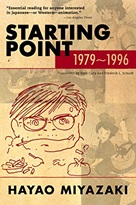Review of 'Starting Point 1979-1996'
Starting Point 1979-1996 by Hayao Miyazaki
 “Starting Point” is a collection of interviews and articles of Japanese Animation director Mayao Miyazaki and co-founder of Studio Ghibli, creators of such masterpieces as “My Neighbour Totoro”, “Princess Mononoke”, “Spirited Away” and “Howl's Moving Castle”. The book is composed of the following chapters:
“Starting Point” is a collection of interviews and articles of Japanese Animation director Mayao Miyazaki and co-founder of Studio Ghibli, creators of such masterpieces as “My Neighbour Totoro”, “Princess Mononoke”, “Spirited Away” and “Howl's Moving Castle”. The book is composed of the following chapters:
- On Creating Animation
- On the Periphery of the Work
- People
- A Story in Color
- My Favourite Things - The only illustrated section of the book including full-colour illustrations as well as black & white pieces along with English translations.
- Planning Notes: Directorial Memoranda
- Works
- Biographical Chronology - A year-by-year chronology of Miyazaki's life.
Each chapter contains several sections, mostly a only a few pages long. The forward “The Cat Bus and Pure Cinematic Magic” is from an interview with John Lassiter passionately talking about Miyazaki and his works while the afterward “The Fireworks of Eros” is by Studio-Ghibli co-founder, director Isao Takahata, aka the “Great Sloth”, who touchingly talks about his relationship with Miyazaki.
What comes across most is Miyazaki's overwhelming dedication to this work and his deep humanity. Over and over again we are reminded of the huge amount of effort that goes into the making of each of his animated masterpieces (generally three years for each film) and, personally, how much of this effort is by Miyazaki himself working 7 days a week as the launch date approaches. We also learn about how the Japanese animation industry operates now with it's huge emphasis on marketing and churning out of large volumes cheaply made (and cheap looking) shows for the Japanese audience. For Studio Ghibli the concentration is on production quality with the careful utilization of technology rather than using it for everything. There is an on-going theme with Miyazaki productions where the story is often not completed before they begin drawing with Miyazaki being forever harangued to provide story outlines.
As you might expect there is a lot of refection on Miyazaki's works as he discusses various aspects with film journalists, historians and fellow directors. It is incredible to hear the amount of thought that has gone into his works, most of which while inspired by Japanese folklore are largely works authored or created from the imagination of Miyazaki himself. Interestingly, Miyazaki is incredibly modest, scoffing at suggestions of how great his films are and is at great pains to point out that film-making is a hugely collaborative work and how input is welcome from anyone on the production team. Despite this it is obvious to see it is his drive and passion that brings the films together into such magnificence on the screen.
Regarding what he thinks of Disney, despite his appreciation for all they have done to distribute his works, he has this to say: “Films must also not be produced out of idle nervousness or boredom, or be used to recognize, emphasize or amplify true vulgarity. And in that context, I must say that I hate Disney's' works. The barrier to both the entry and exit of Disney films is too low and too wide. To me, they show nothing but contempt for the audience.” Miyazaki prefers instead to challenge his audiences, letting them decide for themselves about the characters or what even happens.
Of Miyazaki himself we learn very little beyond his work in the animation industry. There are some biographical comments about where he came from with his love of drawing manga during university where he was nominally enrolled in the “political economy” department to his becoming a lowly animator at Toei Animation where he worked his way up to eventually (co-)found his own studio. What is clear is that he is passionate about the environment and concerned about how children are being raised. He is not at all pleased with the focus Japanese parents have on pushing their children into formal education at a very young age without allowing children to be children. He is also not a fan of coddling children suggesting instead that by letting them hurt themselves and discover the harsh realities of life they become better rounded adults. One point made is that he has found the art created by children before learning to read is more interesting and innovative than the art they create afterwards suggesting that a formal education at a young age is not good for them - They need to be left to play and “be a kid”. Needless to say, he is not a fan of allowing children to watch hours and hours of television/films (even his own - he admits he lives a life of contradictions) or endlessly playing with digital devices but rather suggests children should be with other children and out playing.
A book that will likely be of interest to die-hard Miyazaki fans or those interested in the modern Japanese animation industry. I found it insightful and extraordinarily interesting but it does require careful reading to fully appreciate. It is also quite long at 461 pages (in paperback).
Rating: “Nearly perfect, but not quite”
Review Date: 2024-02-18
Genre: Non-Fiction
Publisher: Viz Media
Publication Date: 1996
ISBN: 9781421561042